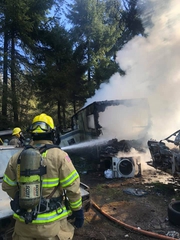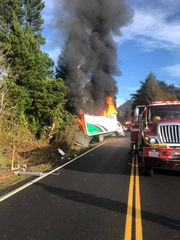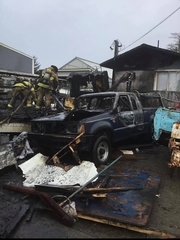Faced with a dramatic decline in revenue, the Crescent Fire Protection District is preparing to submit a funding measure to ask what level of service residents want.
Seeking public input on what the district is proposing, Fire Chief Bill Gillespie will be holding an informational meeting April 14 to discuss the proposed assessment. The meeting will be held at 5 p.m. via Zoom. The link to the meeting will be posted on the district’s website: cfpd.crescentcity.org or call 464-2421 for more information.
“The goal of this assessment is to maintain and improve the level of service to the community and to support a reliable and effective volunteer organization for years to come,” said Gillespie.
Crescent Fire Protection District did not receive property owner support last fall for a similar measure. This was in part due to the timing of other ballot measures proposed by the city and county. CFPD is trying again in hopes to better educate property owners of the importance of approving a special assessment at a rate of $74 per Equivalent Benefit Unit which corresponds with a typical single-family residence. For improved commercial/industrial and governmental parcels, the assessment would be assigned a weighted factor of 1.1 EBU per 2,500 square feet. The proposed maximum annual assessment for larger commercial centers and multi-family complexes is proposed to be capped at $1,000 per parcel.
If approved, the assessment would be continuous and have no sunset clause.
CFPD property owners previously approved two other assessments to pay for fire service. One was established in 1987 at a rate of $24 per EBU, which has no sunset clause or inflationary provision and generates approximately $147,000 in revenue per year. A second was established in 2006 at a rate of $18 per EBU, which generates approximately $110,000 per year. The 2006 assessment is tied to a long-term equipment lease that sunsets this year.
If passed, the new assessment at $74 per EBU would replace the 2006 assessment and would be in addition to the 1987 assessment. Therefore, a typical single-family residence would be paying a total of $98 per year, an increase of $56 per year. Spread over an entire year, the $56 increase is less than $5 per month. The total $98 assessment value would equal just $8.17 per month.
Describing the many financial pressures facing the district, Chief Gillespie said they include the increasing cost of equipment, rising costs for such things as workers’ compensation and higher training levels.
“The district is now facing a serious shortfall with implications for what kind of service residents will see going forward,” Gillespie said.
For many years, CFPD has operated at a deficit, requiring funding be moved from the reserve account to balance the operational budget each year to maintain service and response, even with the 1987 and 2006 assessments. The assessment passed in 2006 is ending this year. The 1987 Assessment, passed over 34 years ago, cannot sustain the increased call volume, mandated training requirements and service demands that are required of fire departments today. In absence of additional funding, CFPD would be forced to reduce response services for medical aid calls which make up approximately 70% of the total annual call volume of more than 2,000 emergency incidents.
This would mean that while CFPD still responded to fires, rescues and extrications, we would not have the funding resources to be able to respond to heart attacks, CPR, chest pain, difficulty breathing, and the other emergency medical calls that that the department often arrives first at. For a person not breathing or with no pulse, brain death occurs in 4-6 minutes. A reduction in funding results in fewer resources responding to critical non-fire life safety calls in the greater Crescent City area.
“CFPD has a long history of saving lives in our community, and we desperately need the funding and resources to continue to serve our community,” Gillespie said.
Funding from this measure would allow CFPD to develop and maintain a 24-hour volunteer staffing program (whereby volunteer firefighters are on duty at the fire station) enabling volunteer personnel to respond quicker to fire and emergency rescue calls. The assessment would also fund ongoing and enhanced training for volunteer firefighters and support improved maintenance, repair, upgrade and/or replacement of aging equipment and apparatus. Inability to maintain and replace equipment and apparatus, and to maintain training has a direct effect on the ISO rating of the fire department. ISO stands for Insurance Services Office, which is an independent organization that evaluates and rates a fire department on their ability to respond and protect their community on a scale from 1 to 10, with 1 being the highest rating. CFPD’s current rating is 4. This rating is used by many insurance companies as they underwrite homeowners and commercial insurance policies for properties. While every developed property value and insurance policy cost is different, a shift from 4 to 5 on the ISO rating can trigger a substantial increase in insurance rates. With the history of wildfires in recent years in California, an increasing number of insurance companies will no longer underwrite insurance policies if an ISO rating slips to 6, and existing insurance can have rates increased substantially or policies cancelled.
If the assessment passes, Gillespie said assessment revenues would generate $421,648 dollars per year beginning in fiscal year 2022, which he said is sufficient to adequately staff the station 24/7.
If it doesn’t pass, Gillespie predicts CFPD would exhaust its limited reserve funds within a two or three year period while trying to maintain the current level of service that residents have come to expect.
Describing the timeline for the assessment vote, ballots will be mailed to property owners at the end of April with a return date of June 14, corresponding with a public hearing held by the district board at 5 p.m. At least a majority of weighted ballots in favor of the proposed benefit assessment must be received for it to go into effect. This measure requires a weighted ballot, meaning each ballot is weighted by the amount of the assessment it represents.
If passed, the assessment would become effective fiscal year 2021-22.




